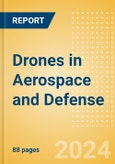This newfound focus has reinvigorated the development of novel military UAVs such as loitering munitions, as well as research into the dual-use potential of consumer drone technology. Loitering munitions in particular are a rapidly expanding segment within the unmanned systems market, combining the benefits of unmanned autonomy and precision-guided munitions within a single platform. The loitering munitions market will benefit from increased modularity, the use of artificial intelligence (AI), the use of swarm technology, and increased sensor capabilities in the next ten years. Simultaneously, recent conflicts have illustrated the utility of repurposing consumer drone technology for defense applications, with the implications of this trend beginning to influence both tactical and strategic considerations within global defense circles.
The publisher estimates that the global military UAV market will expand from a value of $10.927 billion in 2023 to $17.963 billion in 2033, growing with a CAGR of 5.10%. The global drone market was worth $15.2 billion in 2020 and will reach $89.6 billion by 2030, with the strongest growth coming from commercial drones, which will record a compound annual growth rate (CAGR) of 32.6% between 2020 and 2030, rising from $3.4 billion in 2020 to $57.0 billion in 2030.
Key Highlights
- Studies of emerging technological trends and their broader impact on the defense market.
- Analysis of the various drone programs and projects currently under development, as well as the diverse range of applications and use cases for this technology in both the civil and military domains.
Who Should Buy
- Our thematic research product, supported by our thematic engine, is aimed at senior (C-Suite) executives in the corporate world, decision makers, and institutional investors.
- Corporations: Helps CEOs, CTOs, and other senior executives of companies understand this key theme, the competitive environment, and the market opportunities.
- Investors: Helps fund managers and other major investors focus on investment opportunities in defense and understand the market around drone technology.
Scope
- The key defense challenges that forces and defense sector suppliers face are covered.
- The investment opportunities for armed forces, suppliers, and institutional investors, across the whole drone technology value chain are covered.
- Highlights from the range different drone related research and development programs currently being undertaken by various military organizations and defense companies.
Reasons to Buy
- Determine potential investment companies based on trend analysis and market projections.
- Gaining an understanding of the market challenges and opportunities surrounding the drones in aerospace and defense theme.
- Understanding how spending on drones and related segments will fit into the overall market and which spending areas are being prioritized.
Table of Contents
- Executive summary
- Players
- Technology briefing
- Anatomy of a Drone
- Drone classification
- Trends
- Technology Trends
- Macroeconomic trends
- Regulatory trends
- Industry analysis
- Market size and growth forecasts
- Global market analysis
- Defense market analysis
- Mergers and acquisitions
- Patent trends
- Hiring trends
- Case Studies
- Current military UAV roles
- Future military UAV roles
- Use of unmanned platforms in Ukraine
- Timeline
- Value Chain
- Hardware
- Airframes
- Components
- Semiconductors
- Software
- Control
- Mapping
- Data analytics
- Security
- Services
- Drones as a service
- Connectivity
- Drone insurance services
- End user
- Commercial drones
- Consumer drones
- Military drones
- Companies
- Public companies
- Private companies
- Sector Scorecards
- Defense scorecard
- Glossary
- Further reading about Thematic Research Methodology
- About the Publisher
- Contact the Publisher
- Drone classification - Types
- Drone classification - US Taxonomy
- Technology trends
- Macroeconomic trends
- Regulatory trends
- Mergers and acquisitions
- Companies: Public companies
- Companies: Private companies
- Glossary
- Further Reading
- Leading players in the drones theme
- Anatomical characteristics of drone platforms
- Global drones revenue 2020 - 2030
- HAPS market overview
- Global military UAV market value ($ million), 2023-2033
- Global military UAV market value by segment ($ million), 2023-2033
- Sub-sector split of global military UAV market by market value ($ million), 2023-2033
- Military UAV cumulative market value by country ($ million), 2023-2033
- Top UAV patent assignees by volume, 2004 to 2023
- UAV patent publication trends, 2004 to 2023
- UAV-linked hiring trends by volume, 2020-2023
- MQ-25 Stingray
- Heavy Lift Challenge
- B-21 Raider
- The drones in defense story
- The drones value chain
- The drones value chain - Airframes
- The drones value chain - Components
- The drones value chain - Semiconductors
- The drones value chain - Software
- The drones value chain - Services
- The drones value chain - Consumer drones
- The drones value chain - Commercial drones
- The drones value chain - Military drones
- Sector scorecard - Companies
- Sector scorecard - Thematic
- Sector scorecard - Valuation
- Sector scorecard - Risk
Companies Mentioned (Partial List)
A selection of companies mentioned in this report includes, but is not limited to:
- Autel Robotics
- DJI
- Parrot
- Skydio
- Yuneec
- Emax
- Air Hogs
- FreeFly
- Hubsan
- UVify
- Walkera
- Alphabet (Google)
- Aerovironment
- AgEagle
- Amazon
- Aerial MOB
- Delair
- Drone Volt
- DroneDeploy
- Kespry
- AVIC
- Boeing
- Airbus
- CASC
- General Atomics
- Lockheed Martin
- Northrop Grumman
- BAE Systems
- Baykar
- Elbit Systems
- Korea Aerospace Industries
- Anduril
- Palantir
- Kratos Defense
- RTX Corp
- Turkish Aerospace Industries
- Rheinmetall








